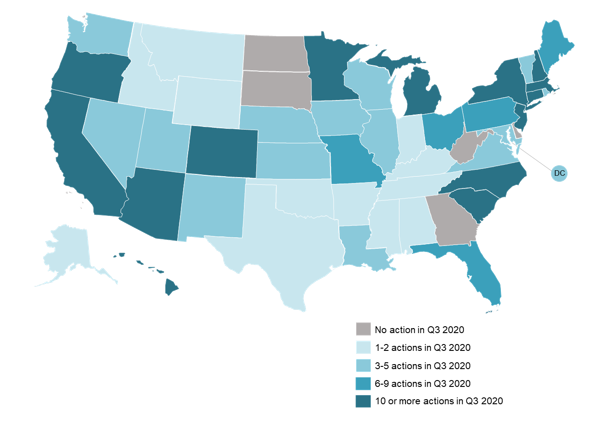The 50 States of Grid Modernization Q3 2020: Utilities Increasingly Developing Distributed and Customer-Centric Solutions
Raleigh, NC – (October 28, 2020) The N.C. Clean Energy Technology Center (NCCETC) released its Q3 2020 edition of The 50 States of Grid Modernization. The quarterly series provides insights on state regulatory and legislative discussions and actions on grid modernization, utility business model and rate reforms, energy storage, microgrids, and demand response.
The report finds that 45 states, as well as the District of Columbia, took actions related to grid modernization during Q3 2020 (see figure below), with the greatest number of actions relating to energy storage deployment (53), distribution system planning (27), smart grid deployment (25), utility business model reforms (24), AMI deployment (23), and data access policies (23).
A total of 382 grid modernization actions were taken during Q3 2020. New York, California, New Jersey, Hawaii, and Massachusetts took the greatest number of actions during the quarter, followed by Connecticut, Michigan, and North Carolina.
Q3 2020 Legislative and Regulatory Action on Grid Modernization

The report discusses three trends in grid modernization actions taken in Q3 2020: (1) utilities proposing customer demand response incentive programs; (2) states studying specific elements of grid modernization; and (3) regulators establishing terms for energy storage qualifying facilities.
“We’re starting to see a lot of states move beyond their expansive grid modernization investigations and study specific elements of grid modernization, develop rules on individual issues, and consider utility deployment proposals,” noted Autumn Proudlove, lead author of the report and Senior Policy Program Director at NCCETC.
The report notes the top five policy developments of Q3 2020 were:
- The Maryland Public Service Commission authorizing multi-year rate plans and performance incentive mechanisms;
- Massachusetts regulators opening its Phase II grid modernization investigation;
- Connecticut and New Jersey utilities filing advanced metering infrastructure proposals;
- South Carolina lawmakers initiating an electricity market reform study; and
- The New York Public Service Commission approving new demand response program rules.
“Utilities have continued to propose incentives for residential customers in exchange for allowing the utility to control behind-the-meter equipment for demand response purposes,” said David Sarkisian, Senior Policy Project Manager at NCCETC. “This equipment can include battery storage, as well as other ‘smart’ devices like thermostats.”
View the 50 States of Grid Modernization Q3 2020 Executive Summary
View and Purchase the 50 States of Grid Modernization Q3 2020 update FULL Report
View other 50 States Reports – Solar, Grid Modernization and Electric Vehicles
ABOUT THE N.C. CLEAN ENERGY TECHNOLOGY CENTER
The N.C. Clean Energy Technology Center, as part of the College of Engineering at North Carolina State University, advances a sustainable energy economy by educating, demonstrating and providing support for clean energy technologies, practices and policies. It serves as a resource for innovative, sustainable energy technologies through technology demonstration, technical assistance, outreach and training. For more information about the Center, visit: http://www.nccleantech.